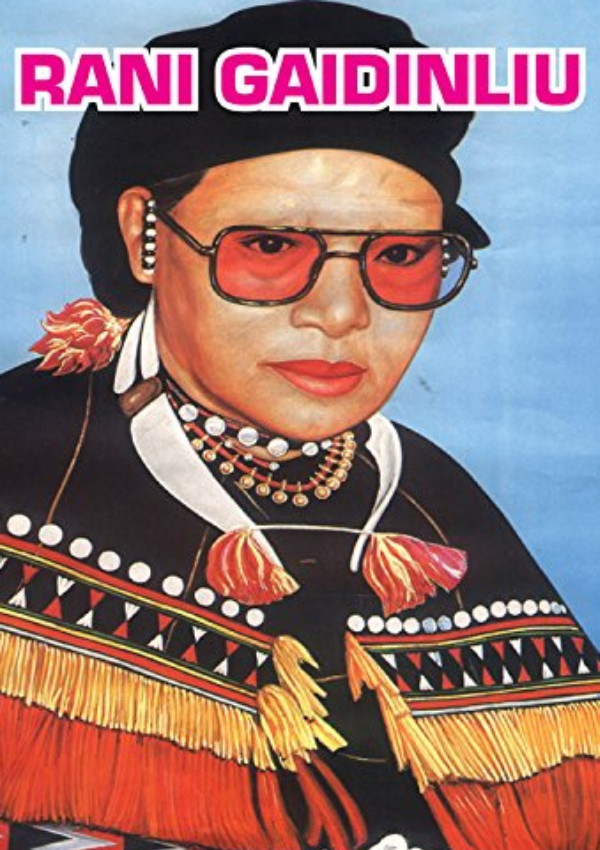Queen Gaidinliu
Queen Gaidinliu


Born on 26th January 1915, at Nungkao Village of Tamenglong district of Manipur, India. She has been called out as the daughter of Hills. She belonged to Rongmei Naga Tribe of India. She was the fifth child out of eight siblings among six sisters and one younger brother. She was born to Lothonang Pamei and Kachaklenliu. Her family belonged to the ruling clan of Village Nungkao. She didn’t pursue any sort of formal education due to the lack of educational institutions of in that area.
She was a spiritual and political leader who revolted against British Rule in India. She joined Heraka movement of her cousin Haipou Jadonang at a tender age of 13 in 1927. Jadonang was a prominent local leader whose main motive was the revival of Naga Tribe Religion (Heraka) by developing resistance against the British Rule to establish Naag Raja.
(Self-Rule). Their movement attracted a large number of Zeliangrong tribes after the arrival of guns from Chachar, Assam their movement turns out to be an armed rebellion against British policies of forced labor and ruthless oppression.
Watching her cousin’s movement closely she got inspired and became her disciple. She became a leader of Guerrilla forces against Britishers at a tender age of 16 in 1930.
One year later, Jadonang got arrested and hanged by the Britishers Gaidinliu, became his spiritual and political successor.
After getting command of the movement, she openly rebelled against the British rule, extorting Zeliangrong people not to pay taxes. Many Naga people joined her as volunteers while others funded her movement.
The British authorities launched a Manhunt for her. She evaded the arrest by the police, moving across the villages of Assam, Nagaland and Manipur.
Governor of Assam ordered Assam rifles against her under the supervision of the Naga Hills Deputy Commissioner J.P. Mills. Several awards were declared by Britishers in lieu of telling her whereabouts.
Her forces have a conflict with the Assam rifles in the North Cachar Hills on 16th Feb 1932 and another on Hangrum Village on 18th March 1932.
On 17th Oct 1932, She was arrested by Captain MacDonald who launched a surprised attack on the Kenoma Village. It has been said that she was building her fortress there due to insufficient arms.
It has also been said that her two followers killed Watchmen of Lakema inspection of Bunglow Hills as he helped as an informer of government for her arrest. Later, she was convicted on the charges of murder and abetment of murder in Imphal where she was sentenced to Life Sentenced. However, she denied the attacks on Hangrum and Watchmen. Most of her followers were either executed or imprisoned.
From 1933 to 1946, she was in jail. There she met Pandit Jawahar Lal Nehru who promised to release her as soon as he became the Interim Prime Minister of India. She was released from Tura jail after serving 14 years of imprisonment in various jails.
She began to live with his younger brother Marang till 1952, after that she went to her native place. In 1953, she addresses issues of heraka movement with Nehru both in Delhi and her native place.
But the resistance still continues after Independence as his own natives opposed her for the integration of Zeliangrong tribes under one administrative unit.
She had a face to face opposition with Naga National Council insurgents who advocated secessionism from India. The Baptist leaders also consider her as an obstacle as her Heraka revival movement were seen as anti- Christian. She was threatened to change her stand.
She went underground in 1960 to strengthen her position and came back with 10,000 men with equipped rifles to defend and press her demand of single Zeliangrong district. She set-up her own quasi-administration named the "Zeliangrong Government of Rani Party" parallel to Phizo’s Naga federal government. In 1964, the over ground Zeliangrong leaders in consultation with underground leaders led by Rani Gaidinliu, demanded "a separate Zeliangrong Administrative Unit or Political Unit" within the Union of India.
On 29 January 1965, her followers kidnapped and killed 9 Naga rebels from the Ngulong village of the Kohima District.
In 1966, she signed out an agreement with the Govt. of India in which she agreed upon the path of non-violence, peaceful and democratic means to address her demands and to end jungle hide-out with then prime minister Lal Bahadur Shastri.
On 24th September 1966, she surrendered 320 of her followers at Henima. Some of them were recruited into Nagaland Armed Police.
She won various prestigious awards which includes Tamrapatra Freedom Fighter Award in 1972, The Padma Bhushan award in 1981, and Vivekananda Sewa Award in 1983 during her stay in Kohima.
She died on 17 February 1993 at the age of 78 at her birthplace.
































